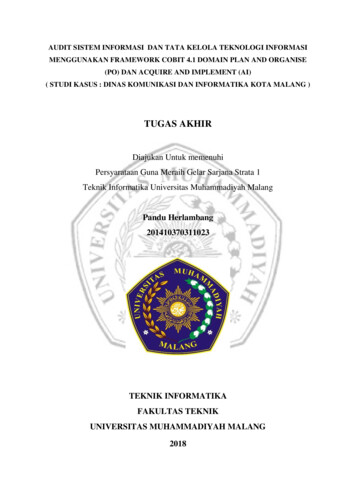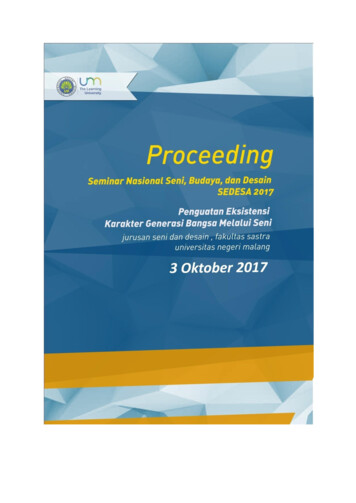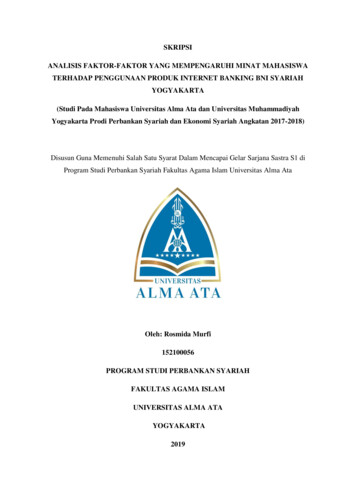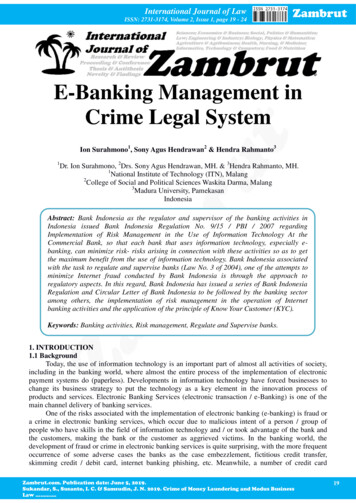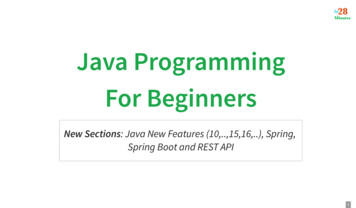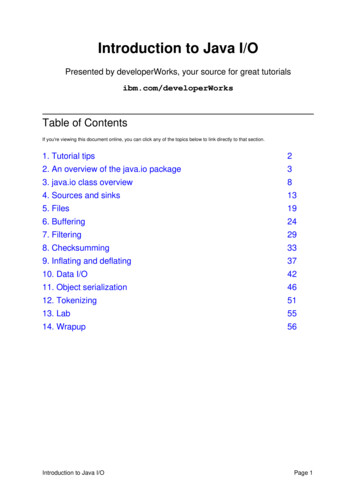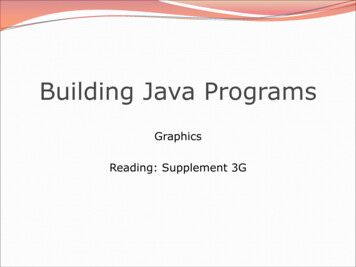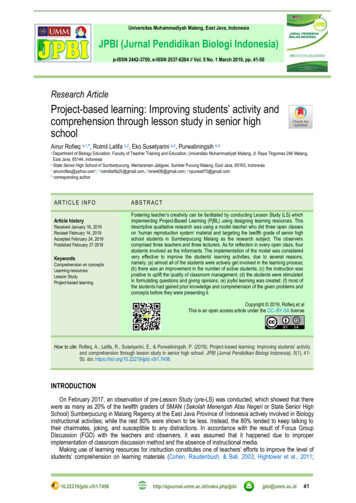
Transcription
Universitas Muhammadiyah Malang, East Java, IndonesiaJPBI (Jurnal Pendidikan Biologi Indonesia)p-ISSN 2442-3750, e-ISSN 2537-6204 // Vol. 5 No. 1 March 2019, pp. 41-50Research ArticleProject-based learning: Improving students’ activity andcomprehension through lesson study in senior highschoolAinur Rofieq a,1,*, Roimil Latifa a,2, Eko Susetyarini a,3, Purwatiningsih b,4Department of Biology Education, Faculty of Teacher Training and Education, Universitas Muhammadiyah Malang, Jl. Raya Tlogomas 246 Malang,East Java, 65144, Indonesiab State Senior High School of Sumberpucung, Mentaraman-Jatiguwi, Sumber Pucung Malang, East Java, 65165, Indonesia1 ainurrofieq@yahoo.com*; 2 roimillatifa20@gmail.com, 3 niniek08@gmail.com; 4 npurwati70@gmail.com* corresponding authoraARTICLE INFOArticle historyReceived January 16, 2019Revised February 14, 2019Accepted February 24, 2019Published February 27 2019KeywordsComprehension on conceptsLearning resourcesLesson StudyProject-based learningABSTRACTFostering teacher’s creativity can be facilitated by conducting Lesson Study (LS) whichimplementing Project-Based Learning (PjBL) using designing learning resources. Thisdescriptive qualitative research was using a model teacher who did three open classeson ‘human reproduction system’ material and targeting the twelfth grade of senior highschool students in Sumberpucung Malang as the research subject. The observerscomprised three teachers and three lecturers. As for reflection in every open class, fourstudents involved as the informants. The implementation of the model was consideredvery effective to improve the students’ learning activities, due to several reasons,namely: (a) almost all of the students were actively get involved in the learning process;(b) there was an improvement in the number of active students; (c) the instruction waspositive to uplift the quality of classroom management; (d) the students were stimulatedin formulating questions and giving opinions; (e) joyful learning was created; (f) most ofthe students had gained prior knowledge and comprehension of the given problems andconcepts before they were presenting it.Copyright 2019, Rofieq et alThis is an open access article under the CC–BY-SA licenseHow to cite: Rofieq, A., Latifa, R., Susetyarini, E., & Purwatiningsih, P. (2019). Project-based learning: Improving students’ activityand comprehension through lesson study in senior high school. JPBI (Jurnal Pendidikan Biologi Indonesia), 5(1), 4150. doi: NOn February 2017, an observation of pre-Lesson Study (pre-LS) was conducted, which showed that therewere as many as 20% of the twelfth graders of SMAN (Sekolah Menengah Atas Negeri or State Senior HighSchool) Sumberpucung in Malang Regency at the East Java Province of Indonesia actively involved in Biologyinstructional activities; while the rest 80% were shown to be less. Instead, the 80% tended to keep talking totheir chairmates, joking, and susceptible to any distractions. In accordance with the result of Focus GroupDiscussion (FGD) with the teachers and observers, it was assumed that it happened due to improperimplementation of classroom discussion method and the absence of instructional media.Making use of learning resources for instruction constitutes one of teachers’ efforts to improve the level ofstudents’ comprehension on learning materials (Cohen, Raudenbush, & Ball, 2003; Hightower et al., .id/index.php/jpbijpbi@umm.ac.id41
JPBI (Jurnal Pendidikan Biologi Indonesia)Vol. 5, No. 1, March 2019, pp. 41-50Rosenshine, 2012; Walberg, 2010). Learning resources, in essence, refer to any objects or situations that areexistent around learning environment (Blazar & Kraft, 2017; Bouzeghoub, Do, & Lecocq, 2007; Coe, Aloisi,Higgins, & Major, 2014; Guardino & Fullerton, 2010; Koper, 2003) and can functionally accommodate andoptimize learning outcomes (Khalil & Elkhider, 2016; Lento et al., 2014; Masino & Niño-Zarazúa, 2016). Manylearning resources can stimulate students’ brain to draw out a concept more concretely so as to trigger easiercomprehension and better knowledge mastery. The selection of learning resources is to be planned by teacher‘by design’ based on particular needs (Fullan & Langworthy, 2014; Kamina & Iyer, 2009; Karamustafaoglu,2009; Niemi, 2009). Accordingly, need assessment is to be administered to syllabus, basic competences,learning objectives, and students’ needs (Bryson, 2013; Cartwright, Weiner, & Streamer-Veneruso, 2010; Hunt,2015). For that reason, Hodge and Anderson (2007) proposes the term ‘instructional media’ as learningresources.In general, learning resources must be prepared by teachers or have been existent in schools (Carr, 2007;Carroll, 2012; Coe et al., 2014; Kohl et al., 2013). Most of teachers have prepared and determined some sortsof learning resources they are going to make use of for instruction by referring to lesson plans. Alluding to 2013Curriculum, teachers are required to make use of learning resources for scientific quality improvement. Withrespect to the observation result (on February 2017), it was reported that all Biology teachers had performedany attempts to procure and make use of learning resources in every instructional session. The learningresources could be the media that had been existent in the school or designed by the teachers; or it could beany situations around learning environment. However, in fact, not all available learning resources covered theintended materials. Hence, the teachers were demanded to be far more creative in planning learning resourcesto use. One of possible solutions offered was to assign the students to independently design their own learningresources in a group through elaborative study on learning objectives, literature review, and learning needs.The implementation of assigning the students to design their own learning resources required propermethod or model of scientific learning (Anderman, Sinatra, & Gray, 2012; Bušljeta, 2013; Coil, Wenderoth,Cunningham, & Dirks, 2010; Dunlosky, Rawson, Marsh, Nathan, & Willingham, 2013; Movahedzadeh, Patwell,Rieker, & Gonzalez, 2012). The main consideration to take into account was that the model was equipped withsyntax, consisting of group working, time allotment for designing learning resources, consultation with theteacher, and presentation. All in all, one of scientific approaches with that sort of syntax is Project-BasedLearning or PjBL (Arce, Miguez, Granada, Miguez, & Cacabelos, 2013; Bell, 2010; Fadly & Wasis, 2017;Greenstein, 2012; Shinde, 2014; Sumarti, Cahyono, & Munafiah, 2015). The PjBL model was implemented byassigning the students, in groups, to independently design and elaborate learning resources from someassorted literatures. According to Dickinson and Jackson (2008) and also Sani (2014) students automaticallycomprehend and learn prior materials before an instructional activity starts.Based on the issue that arose on the observation and FGD (on February 2017), LS was piloted as apractice of teacher’s professional training for Biology subject on the twelfth graders of senior high school level.Further, the focus of the LS was ‘to implement PjBL model through a project of independently designinglearning resources in groups outside the classroom meeting hours to improve the students’ activities andcomprehension on Biology concepts.METHODThis descriptive qualitative research was implemented LS on the twelfth graders of the senior high schoolattending Natural Science (or Ilmu Pengetahuan Alam/IPA), specifically on class XII IPA-1 (31 students) and XIIIPA-2 (30 students) during even semester on academic year 2017/2018 under ‘Human Reproduction System’material. The one appointed as a model teacher was a Biology teacher for the twelfth graders of the senior highschool. Meanwhile, three lecturers from Department of Biology Education, the Faculty of Teacher Training andEducation-University of Muhammadiyah Malang and three teachers from the same school as that of the modelteacher were set as observers. Thereunto, LS was run in three instructional activities, March to May 2017.The instruction was initiated by pre-LS on February 2017 by administering observation and FGD aboutinstructional activities commonly performed by Biology teachers. Next is LS implementation in which it wasadministered in three instructional activities: open class-1 in class XII IPA-1 by means of pictures in thestudents’ book as learning resources; open class-2 in class XII IPA-1 by means of PowerPoint created by thestudents; open class-3 in class XII IPA-2 by means of media independently designed by students. In openclass-1, the instructional model used was Problem Based Learning (PBL), and in the next open class, PjBL waschosen. The syntax of PjBL used in the LS was referred to a guideline from the Ministry of Education andCulture comprising six phases, to name: (1) problem delivery; (2) planning a project; (3) setting a schedule; (4)monitoring; (5) testing on results; and (6) evaluation on experience. Withal, a scheme of LS implementation isshown in Table 1.42Rofieq et.al (Project-based learning: Improving students’ )
JPBI (Jurnal Pendidikan Biologi Indonesia)Vol. 5, No. 1, March 2019, pp. 41-50No Scheme1. Month(s)2. Material(s)3. Model(s)4. Class(es)5. LearningResources(media)6. Method(s) ofData CollectionTable 1. A Series of activities and schedule of the instructionalOpen Class-1Open Class-2Open Class-3March 2017March 2017April 2017Plant ReproductionHuman Reproduction SystemHuman Reproduction SystemSystemProblem Based Learning Project-Based Learning (PjBL) Project-Based Learning (PjBL)(PBL)XII IPA-1XII IPA-1XII IPA-2Pictures in the Students’PowerPoint created by theMedia designed by theBookstudentsstudentsObservation, FGD, andInterviewObservation, FGD, andInterviewObservation, FGD, andInterviewRESULTS AND DISCUSSIONThere were three open classes of instructional activities. Open class-1 constituted preliminary phase of LS(Pre-LS). Meanwhile, open class-2 and open class-3 were conducted by means of LS.Open class-1Open class-1 constituted Pre-LS, which was administered in class XII IPA-1. Pre-LS was a phase in whichthe teacher accommodated a regular instruction without any LS implementation on ‘Human ReproductionSystem’ material by implementing PBL model. The essential aim of the program was to identify instructionalcharacteristics, such as overall situation, common habit and behavior shown by the Biology teacher in termsof classroom management, the students’ activities during class, and classroom overall condition.During the instruction, the teacher started the class by distributing worksheet with four pictures of howplant underwent its reproduction process along with several problems and questions written next to them.After all the students received the worksheet, the teacher explained the pictures with several examples ofreproduction process that happened around the students’ environment. The teacher, then, divided thestudents into six groups. Each of the groups was to discuss the problems and questions based on the picturesbefore jotting down their answers. The next phase was that the students were involved in classroomdiscussion in order to analyze and synthesize problems and the most correct answers. At last, the teacher,together with some of the students, performed a critical analysis to clarify the answers.Alluding to the observation result in terms of classroom conduciveness, it was shown that there were 15 ofthe students actively focused on the instruction; while the rest 16 were shown to be less attentive. Somefollowing details were tapped: the classroom condition was crowded; many students kept talking to their chairmates; many moved from their own chairs to other chairs (from row to row); some did not really get involved inthe discussion; and some seemed to open and read some other books. Moreover, in classroom discussionsession, as many as a quarter of the students showed their critical thinking process in formulating questionsor sharing their thoughts, through analysis and synthesis on the concepts served in the material.In FGD session with the model teacher, observers, and six representatives of the students, it wasidentified that some of the students did not fully comprehend the problems. As the consequence, neither werethey interested in group nor classroom discussion. All the students claimed that the learning situation andcondition were still the same as usual. One detectable drawback of conventional instruction is that studentsare shown to be less contributive to the instruction. One of determinant factors that causes students’ learningoutcomes to be less optimal is abstractly conducting instructional activities (Dickinson & Jackson, 2008). Forthat reason, teachers are demanded to be more innovative and selective to take into account, choose, andimplement scientific models of instruction (Cajkler, Wood, Norton, Pedder, & Xu, 2015; Isabekov & Sadyrova,2018). Further, scientific model of instruction is believed to give students a chance to perform life-basedlearning through life experiences.Implementing scientific model of instruction completely requires teachers’ skill and experiences inmanaging the instruction. Indeed, they are demanded to be well-experienced in collaborating with otherteachers or lecturers to optimize learning outcomes. Consequently, the LS team agreed to set open class-2 bydesign with LS as a model of professional training program. According to Saito and Atencio (2015), LSconstitutes a model of teachers’ professional training through collaborative instructional review.43Rofieq et.al (Project-based learning: Improving students’ )
JPBI (Jurnal Pendidikan Biologi Indonesia)Vol. 5, No. 1, March 2019, pp. 41-50Open class-2In open class-2, LS was implemented in the same class, XII IPA-1. It focused on ‘Human ReproductionSystem’ material. The open class-2 was designed by referring to the reflection on the previous instructionalactivity. The main facets to concern on for betterment were instructional model and learning resources. TheLS team agreed to make use of PjBL as the instructional model; while learning resources were to be treatedas the students’ group project.PlanningThis stage was initiated by ‘planning’. The LS team, comprising three lecturers from UMM, a modelteacher, and four teacher observers, had conducted a workshop to set a lesson plan on ‘Human ReproductionSystem’ material and to design the syntax of PjBL. The design was made collaboratively in the forms ofchapter design and lesson design by considering basic competence, material indicators, substances of lessonplan, as well as the students’ and teacher’s needs for instruction. The results of chapter design and the lessondesign are displayed in Figure 1. The LS team decided that the chosen material, ‘Human ReproductionSystem’, was divided into three subcategories, namely: ‘male and female reproduction organs’, ‘physiologicalprocess of reproduction’, and ‘reproduction health’. For the project, the students were assigned to createinstructional media for presentation by means of Microsoft PowerPoint program. The instructional activity wasrun by means of PjBL syntax based on the guideline from the Ministry of Education and Culture.Figure 1. The results of lesson design for open class-2ImplementationIn the implementation, the teacher implemented PjBL model to accommodate the instruction as agreed bythe LS team. The first, second, and third syntaxes were implemented in the first meeting (during theclassroom meeting hours) for about 30 minutes. The fourth syntax was administered outside the classroommeeting hours for six days. Next, the fifth and sixth were administered during the classroom meeting hours for2 x 45 minutes. In detailed, the followings are the descriptions of each stage performed in class: (1) syntax-1:problem delivery which constituted the first phase where the teacher shared some common problems inrespect to ‘Human Reproduction System’; (2) syntax-2: planning the project in which the teacher divided thestudents into six groups – with two groups working on learning resources about physical characteristics ofpuberty, two groups on reproduction physiology, and two groups on reproduction health. The teacherexplained to the students that the project was to be completed outside the classroom meeting hours in sixdays; (3) syntax-3: setting the schedule where the teacher and students, altogether, made an agreementabout consultation for project development; syntax-4: monitoring, which allowed the teacher to intensivelyobserve the students’ progress in finishing the project outside the classroom meeting hours based on thestipulated schedule; and syntax-5: testing on the results in which each of groups was to present the result ofthe project (Figure 2).44Rofieq et.al (Project-based learning: Improving students’ )
JPBI (Jurnal Pendidikan Biologi Indonesia)Vol. 5, No. 1, March 2019, pp. 41-50Figure 2. A group of students of XII IPA-1 presenting their learning resources for ‘Human Reproduction System’ materialThe teacher invited the students to discuss some problems that had been shared and explained in syntax1 by means of media they had designed. During the meeting, the teacher gave a chance to the students toanalyze and evaluate three materials delivered about reproduction system. The teacher also set timeallotment to criticize and give feedbacks on the substances of the material included in the media designed byother groups. In syntax-6, the teacher gave a chance to all the students to evaluate their experiences indesigning the project. However, the last syntax could not be implemented for the time had almost beenrunning out, remaining 15 minutes. Consequently, the teacher switched to instructional reflection and followup. The LS team observed all stages implementing PjBL, excluding syntax-4, monitoring. The session ofmonitoring was executed by the model teacher outside the classroom meeting hours. Besides, the LS teamconducted an interview with the model teacher and six students (representing each of the groups). Theobservation took place during the instructional activities; while the interview was conducted after theinstructional activities were completed.ReflectionThe LS team made a reflection after the instructional activities. The method for reflection was based ontwo techniques, namely: evaluating the instruction and comparing to open class-1. The LS team revealed that,based on the observation on classroom conduciveness, the number of active and attentive students (23)higher than the previous session did (17). It explicated that as many as 8 students were shown to be lessactive as the learning atmosphere was somehow unconducive as that in open class-1. It was illustrated by thefollowings: some of the students preferred talking to their chair-mates; some of them kept moving from one toanother chair (row to row); some seemed ‘not really’ involved in group and classroom discussions; someopened some other books other than Biology book; and there were two groups busy to revise and improvisetheir PowerPoint slides in their laptops. In classroom discussion, students were more stimulated in formulatingquestions and sharing their thoughts, from 10 to 16 students. The students were confident to analyze,synthesize, and evaluate the concepts, which had been a serious problem in learning, all this time.The result of FGD with the model teacher, observers, and student representatives resulted in a fact thatthere were some of the students with the lack of comprehension on the problems under discussion. They feltuninterested in analyzing and discussing the project, either in a group or classroom context. In addition, thereasons why they were less participative on the project was that they could not operate PowerPoint program,they did not have any laptop, and only few students operated the PowerPoint slides during presentation. Allthe students admitted that the learning situation or condition was better than that in open class-1, with thejoyful learning increase. The model teacher also assumed that there was a syntax in PjBL model seemingunfeasible. The burden the teacher might have to face was when she was to visit her students’ houses one byone to observe the progress of media creation. As there were six different groups, the teacher was to monitor,at least, six times in total. In addition, the LS team concluded that syntax-6, evaluation on experiences indesigning the project, was not effective to foster the students’ mastery on the learning material. According toSaito and Atencio (2015), in implementing LS, it is necessary that teachers choose the most effective activity.45Rofieq et.al (Project-based learning: Improving students’ )
JPBI (Jurnal Pendidikan Biologi Indonesia)Vol. 5, No. 1, March 2019, pp. 41-50Based on the result of reflection, it was recommended that the fore-coming PjBL instructional activities bemore effective in terms of learning process, quality of learning resources, and the students’ participation indeveloping learning resources. PjBL model would give a broader chance to students to partake and beresponsible for instruction (Arce et al., 2013; Fadly & Wasis, 2017; Greenstein, 2012; Kokotsaki, Menzies, &Wiggins, 2016; Savery, 2006). According to Holubova (2008) and Kokotsaki et al. (2016), PjBL could raise aconstructive investigation and reflection on the real life. For that reason, designing instructional activity shouldfocus more on students.Open class-3Open class-3 was designed to highlight and accommodate what was recommended by open class-2. Thetargeted foci of instructional training to be maintained were the syntax of PjBL and technique of learningresource development.PlanningThe LS team held a workshop to design a scheme of new instruction based on what was gained in openclass-2. The syntax of PjBL was compressed from six to four. The four agreed syntaxes comprised planning,creating, presenting, and evaluating. The consideration to cut the syntax was based on Savery (2006) andalso Saito and Atencio (2015) who underpin that instructional activities have to be designed as effective aspossible. In the syntax of newly designed PjBL, two syntaxes were removed, namely monitoring andevaluation on experiences during the project. Further, the technique for material development by groups ofstudents was replaced by learning resources, in the form of visual media, independently created by thestudents. The learning material was set the same as that in open class-2, ‘Human Reproduction System’, butthe class was made different, which was on class XII IPA-2. For chapter design and plot of lesson design, thematerial was still adopted from the design used in open class-2 (see Figure 1). Notwithstanding, the draft oflesson plan was changed as shown in Figure 3.Figure 3. The illustration of lesson plan summary during the lesson design in open class-3ImplementationIn its implementation, the teacher applied the syntax of newly designed PjBL comprising four syntaxes.Syntax-1 was implemented by the teacher and students in the classroom on the first meeting for 30 minutes.Syntax-3 and syntax-4 were conducted by the teacher and students altogether in 2 x 45 minutes. Meanwhile,syntax-2 was piloted outside the classroom meeting hours for six days by the students in groups. Syntax-1was planning, in which the model teacher delivered problems related to human reproduction system andinvited the students to get involved in interactive discussion. Next, the teacher gave the students project to46Rofieq et.al (Project-based learning: Improving students’ )
JPBI (Jurnal Pendidikan Biologi Indonesia)Vol. 5, No. 1, March 2019, pp. 41-50design media and divided them into six different groups–with two groups concerning on physical characteristicof puberty, two groups on reproduction physiology, and two others on reproduction health. The teacherinformed that the project had to be completed outside the classroom meeting hours within six days. Theteacher and students, therefore, agreed to set a schedule of classroom consultation for the progress.Syntax-2 was creating, where the students, together with their own group, started to design and developlearning resources labelled as the students’ creation media. The must-exist guideline for elaboration washuman reproduction system material accommodated in the students’ book with additional materials from othersources, such as internet and textbooks. As for the elaboration, the students were given a chance to consultwith the model teacher during break-time at the school. Syntax-3 was presenting, in which each of the groupswas to present the media created. The teacher also invited the students to get involved in solving theproblems that arose in syntax-1 by means of media they created (Figure 4). In this meeting, the teacher gavethe students a chance to analyze and evaluate three materials about reproduction system. In addition, theteacher set time allotment to criticize and give feedbacks to some substantial aspects of the learningresources created by other groups. Syntax-4 was evaluating, in which the teacher invited the students tomake a conclusion and reflection concerning on the instruction. At last, the session was ended by deliveringsome advices and follow-up from the teacher on the reproduction health material in a real life.ABFigure 4. Two examples of learning resources created by the students related to reproductive organ physiology (A) andpuberty physical character (B)ReflectionThe LS team did a reflection to evaluate the instructional activities and make a comparison to open class2. The LS team revealed that, based on the observation, in term of classroom conduciveness, almost of allstudents were active, reach 27 from 30 students. In other words, only 3 students were categorized as passive,showing that during classroom discussion there were still some of whom who kept talking to their chair mates.However, unconducive situations as those in open class-1 and open class-2, such as moving from one toanother chair (row to row), ‘not really’ getting involved in group and classroom discussions, opening someother books other than Biology book, and being busy to revise and improvise their PowerPoint slides in theirlaptops, were no longer found. In classroom discussion, it was shown that there was improvement on thenumber of students with critical thinking in formulating questions and sharing thoughts, which finally reached24 students. As shown in open class-2, the students were confident to analyze, synthesize, and evaluate theconcepts which might be their learning problems, all this time. The excellence of open class-3 was that someof the students from different groups were able to explain and evaluate some issues regarding reproductionhealth based on their real life by departing from relevant concepts, theories, and learning resources.Based on the result of FGD during the reflection session, it was probed from the observers and studentsthat most of the students found the answers and comprehended the problems delivered in syntax-1. It wassince almost all of the members of the groups actively involved in elaborative activity of designing learning47Rofieq et.al (Project-based learning: Improving students’ )
JPBI (Jurnal Pendidikan Biologi Indonesia)Vol. 5, No. 1, March 2019, pp. 41-50resources. All the students admitted that the situation and condition of the instruction were far better than thatof open class-2 with the joyful learning was created. Evaluating the students’ media (see Figure 4), the LSteam revealed that the students succeeded in elaborating and developing learning resources despite thedummy version of their creation. The instructional media, withal, had been used by the students tocomprehend and memorize biological concepts concretely. From pedagogical perspective, it could be saidthat the students actively involved in the instructional activities to lower down the teacher’s dominance inexplaining the materials. According to Bell (2010), Darling-Hammond (2006), and also Greenstein (2012), themost remarkable characteristic of instruction in 21st-Century is that teachers have to reduce their beingdomineering in class.The notion related to the reduction of teachers’ dominant role upon teaching has provided a scientificfoundation to alleviate the syntax of PjBL from six to four (Darling-Hammond, 2006; Fadly & Wasis, 2017;Kokotsaki et al., 2016). The four syntaxes of PjBL in this current research comprised planning, creating,presenting, and evaluating. By doing so, it has activated the teacher to be the learning facilitator. The results ofobservation, in addition, contribute a scientific support that the students and their groups are play theirdominant roles during the instruction in all stages of learning. Many researchers and expert has confirmed thatthe implementation of PjBL model could be positive to all students, especially to improve their motivation andfocus on instructional activities (Chiang & Lee, 2016; Crippen et al., 2016; Husamah & Pantiwati, 2014;Movahedzadeh et al., 2012) .CONCLUSIONThis current Lesson Study has recommended the reduction of the syntax of PjBL model as guided in a bookof Ministry of Education and Culture, year 2014, from six to four, comprising planning, creating, presenting, andevaluating. In PjBL model, the students were able to design their own media in groups by elaborating thematerials from the textbooks and other supporting sources. The implementation of PjBL through the project ofmedia creation was considered effective to improve the students’ learning quality. There were quantitativeindicators to prove, as follows: (a) almost all of the students were shown to actively get involved in the learningprocess; (b) there was an improvement in the number of active students than those
East Java, 65144, Indonesia b State Senior High School of Sumberpucung, Mentaraman-Jatiguwi, Sumber Pucung Malang, East Java, 65165, Indonesia 1 ainurrofieq@yahoo.com*; 2 roimillatifa20@gmail.com, 3 niniek08@gmail.com; 4 npurwati70@gmail.com * corresponding author INTRODUCTION
